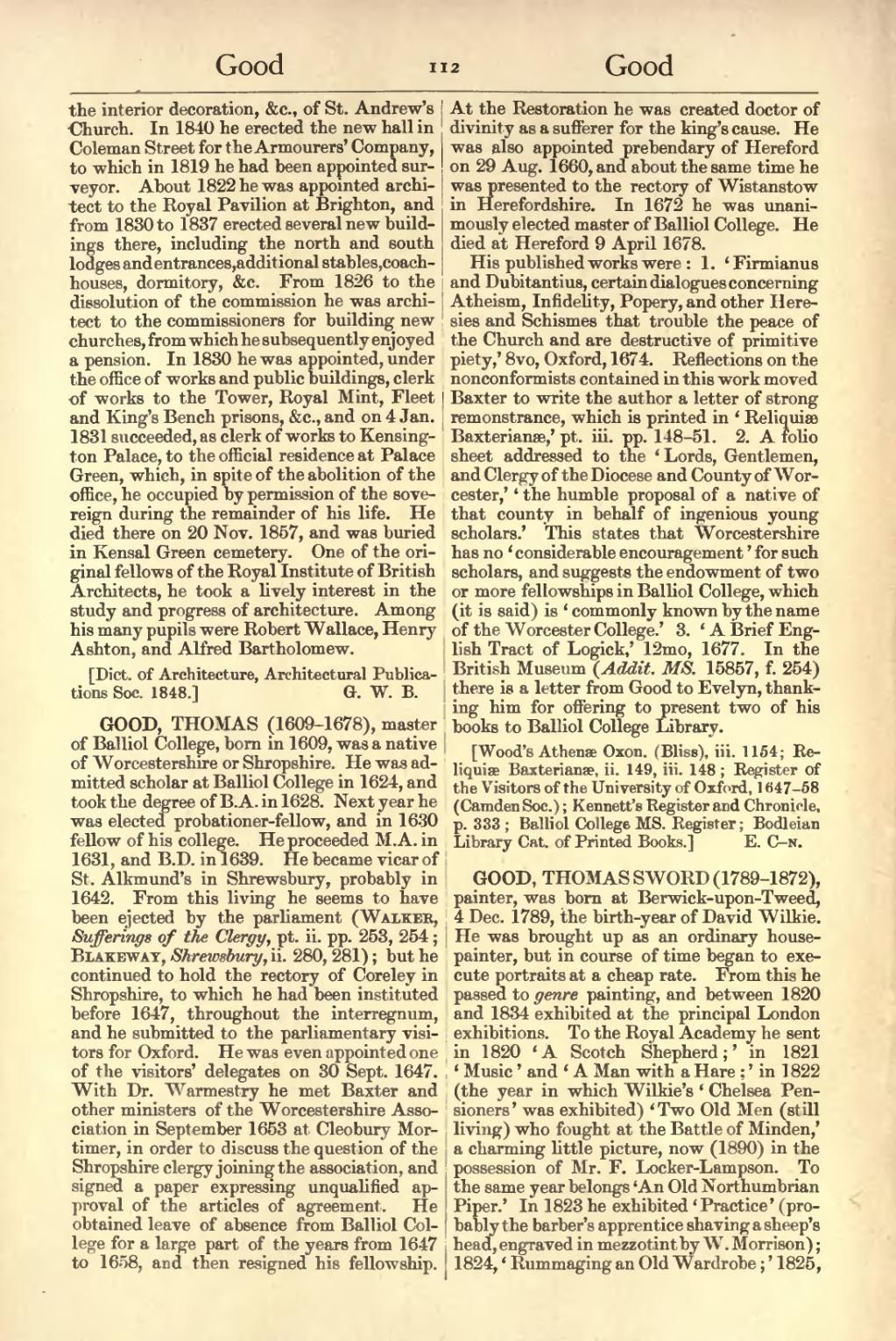the interior decoration, &c., of St. Andrew's Church. In 1840 he erected the new hall in Coleman Street for the Armourers' Company, to which in 1819 he had been appointed surveyor. About 1822 he was appointed architect to the Royal Pavilion at Brighton, and from 1830 to 1837 erected several new buildings there, including the north and south lodges and entrances, additional stables,coach-houses, dormitory, &c. From 1826 to the dissolution of the commission he was architect to the commissioners for building new churches, from which he subsequently enjoyed a pension. In 1830 he was appointed, under the office of works and public buildings, clerk of works to the Tower, Royal Mint, Fleet and King's Bench prisons, &c., and on 4 Jan. 1831 succeeded, as clerk of works to Kensington Palace, to the official residence at Palace Green, which, in spite of the abolition of the office, he occupied by permission of the sovereign during the remainder of his life. He died there on 20 Nov. 1857, and was buried in Kensal Green cemetery. One of the original fellows of the Royal Institute of British Architects, he took a lively interest in the study and progress of architecture. Among his many pupils were Robert Wallace, Henry Ashton, and Alfred Bartholomew.
[Dict. of Architecture, Architectural Publications Soc. 1848.]
GOOD, THOMAS (1609–1678), master of Balliol College, born in 1609. was a native of Worcestershire or Shropshire. He was admitted scholar at Balliol College in 1624, and took the degree of B.A. in 1628. Next year he was elected probationer-fellow, and in 1630 fellow of his college. He proceeded M.A. in 1631, and B.D. in 1639. He became vicar of St. Alkmund's in Shrewsbury, probably in 1642. From this living he seems to have been ejected by the parliament (Walker, Sufferings of the Clergy, pt. ii. pp. 253, 254; Blakeway, Shrewsbury, ii. 280, 281); but he continued to hold the rectory of Coreley in Shropshire, to which he had been instituted before 1647, throughout the interregnum, and he submitted to the parliamentary visitors for Oxford. He was even appointed one of the visitors' delegates on 30 Sept. 1647. With Dr. Warmestry he met Baxter and other ministers of the Worcestershire Association in September 1653 at Cleobury Mortimer, in order to discuss the question of the Shropshire clergy joining the association, and signed a paper expressing unqualified approval of the articles of agreement. He obtained leave of absence from Balliol College for a large part of the years from 1647 to 1658, and then resigned his fellowship. At the Restoration he was created doctor of divinity as a sufferer for the king's cause. He was also appointed prebendary of Hereford on 29 Aug. 1660, and about the same time he was presented to the rectory of Wistanstow in Herefordshire. In 1672 he was unanimously elected master of Balliol College. He died at Hereford 9 April 1678.
His published works were: 1. 'Firmianus and Dubitantius, certain dialogues concerning Atheism, Infidelity, Popery, and other Heresies and Schismes that trouble the peace of the Church and are destructive of primitive piety,' 8vo, Oxford, 1674. Reflections on the nonconformists contained in this work moved Baxter to write the author a letter of strong remonstrance, which is printed in 'Reliquiae Baxterianae,' pt. iii. pp. 148-51. 2. A folio sheet addressed to the 'Lords, Gentlemen, and Clergy of the Diocese and County of Worcester,' 'the humble proposal of a native of that county in behalf of ingenious young scholars.' This states that Worcestershire has no 'considerable encouragement' for such scholars, and suggests the endowment of two or more fellowships in Balliol College, which (it is said) is 'commonly known by the name of the Worcester College.' 3. 'A Brief English Tract of Logick,' 12mo, 1677. In the British Museum (Addit. MS. 15857, f. 254) there is a letter from Good to Evelyn, thanking him for offering to present two of his books to Balliol College Library.
[Wood's Athenæ Oxon. (Bliss), iii. 1154; Reliquiæ Baxterianæ, ii. 149, iii. 148; Register of the Visitors of the University of Oxford, 1647-58 (Camden Soc.); Kennett's Register and Chronicle, p. 333; Balliol College MS. Register; Bodleian Library Cat. of Printed Books.]
GOOD, THOMAS SWORD (1789–1872), painter, was born at Berwick-upon-Tweed, 4 Dec. 1789, the birth-year of David Wilkie. He was brought up as an ordinary house-painter, but in course of time began to execute portraits at a cheap rate. From this he passed to genre painting, and between 1820 and 1834 exhibited at the principal London exhibitions. To the Royal Academy he sent in 1820 'A Scotch Shepherd;' 'in 1821 'Music' and 'A Man with a Hare;' in 1822 (the year in which Wilkie's 'Chelsea Pensioners' was exhibited) 'Two Old Men (still living) who fought at the Battle of Minden,' a charming little picture, now (1890) in the possession of Mr. F. Locker-Lampson. To the same year belongs 'An Old Northumbrian Piper.' In 1823 he exhibited 'Practice' (probably the barber's apprentice shaving a sheep's head, engraved in mezzotint by W. Morrison); 1824, 'Rummaging an Old Wardrobe;' 1825,
